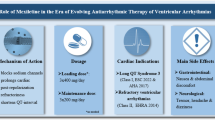Summary
In order to determine whether the positive inotropic action of cardiac glycosides is related to the inhibition of sodium pump activity, the actions of known inhibitors:N-ethylmaleimide,p-chloromercuribenzoate (PCMB),p-chloromercuribenzene sulfonic acid (PCMBS) and digitoxin, were studied in isolated guinea pig hearts. In electrically driven left atrial preparations, all these agents increased isometric contractile force. The inotropic effect ofN-ethylmaleimide was only partially reduced in the presence of propranolol or by reserpine pretreatment, whereas the inotropic effects of PCMB and PCMBS were unaffected by reserpine pretreatment. (±)-Propranolol markedly delayed the development of the inotropic action of PCMB and PCMBS without affecting the magnitude of the peak inotropic response. Similar effect was observed with (+)-propranolol indicating that the delayed development of the inotropic action is probably due to the action of propranolol unrelated to β-adrenergic blockade. Among sulfhydryl blocking agents, the development of the inotropic effects was fastest withN-ethylmaleimide and slowest with PCMBS. Effects of these sulfhydryl inhibitors on resting potential and action potential were unrelated to the inotropic action. These agents caused a decrease in ouabain-sensitive86Rb uptake, an estimate of sodium pump activity, in sodium-loaded ventricular slices obtained from drug-perfused Langendorff preparations. Quantitative comparisons between the degree of inotropic response and sodium pump inhibition caused by these agents were not possible because of the difference in experimental conditions. These results, however, are consistent with the hypothesis that Na+, K+-ATPase inhibitors cause positive inotropic effects associated with sodium pump inhibition.
Similar content being viewed by others
References
Akera, T., Brody, T. M.: Inotropic action of digitalis and ion transport. Life Sci.18, 135–142 (1976)
Akera, T., Bennett, R. T., Olgaard, M. K., Brody, T. M.: Cardiac Na+,K+-adenosine triphosphatase inhibition by ouabain and myocardial sodium: A computer simulation. J. Pharmacol. Exp. Ther.199, 287–297 (1976a)
Akera, T., Ku, D. D., Frank, M., Brody, T. M., Iwasa, J.: Effects of grayanotoxin I on cardiac Na+, K+-ATPase activity, transmembrane potential, and on myocardial contractile force. J. Pharmacol. Exp. Ther.199, 247–254 (1976b)
Barrett, A. M., Cullum, V. A.: The biological properties of the optical isomers of propranolol and their effects on cardiac arrhythmias. Br. J. Pharmacol.34, 43–55 (1968)
Benforado, J. M.: The veratrum alkaloids. In: Physiological Pharmacology (W. S. Root, F. G. Hofmann, eds.), Vol. 4, part D, pp. 331–398. New York: Academic Press 1968
Bennett, D. R., Andersen, K. S., Andersen, M. V., Jr., Robertson, D. N., Chenoweth, M. B.: Structure-activity analysis of the positive inotropic action of conjugated carbonyl compounds on the cat papillary muscle. J. Pharmacol. Exp. Ther.122, 489–498 (1958)
Besch, H. R., Jr., Schwartz, A.: On the mechanism of action of digitalis. J. Mol. Cell. Cardiol.1, 185–199 (1970)
Brody, T. M., Akera, T.: Relations among Na+, K+-ATPase activity, sodium pump activity, transmembrane sodium movement, and cardiac contractility. Fed. Proc.36, 2219–2224 (1977)
Dutta, S., Goswami, S., Datta, D. K., Lindower, J. O., Marks, B. H.: The uptake and binding of 6 radiolabelled cardiac glycosides by guinea-pig hearts and by isolated sarcoplasmic reticulum. J. Pharmacol. Exp. Ther.164, 10–21 (1968)
Freer, R. J., Pappano, A. J., Peach, M. J., Bing, K. T., McLean, M. J., Vogel, T., Sperelakis, N.: Mechanism for the positive inotropic effect of angiotensin II on isolated cardiac muscle. Circ. Res.39, 179–183 (1976)
Fricke, U.: Neuere Erkenntnisse über den Wirkungsmechanismus der Herzglykoside. Fortschr. Med.94, 1837–1845 (1976)
From, A. H. L.: N-Ethylmaleimide (NEM) induced inotropism. Clin. Res.18, 306 (1970)
From, A. H. L., Probstfield, J.:P-Chloromercuribenzene sulfonic acid induced inotropism. Fed. Proc.30, 632 Abs. (1971)
Horackova, M., Vassort, G.: Excitation—contraction coupling in frog heart: Effect of veratrine. Pflügers Arch.352, 291–302 (1974)
Ku, D., Akera, T., Pew, C. L., Brody, T. M.: Cardiac glycosides: Correlations among Na+, K+-ATPase, sodium pump and contractility in the guinea pig heart. Naunyn-Schmiedeberg's Arch. Pharmacol.285, 185–200 (1974a)
Ku, D., Akera, T., Tobin, T., Brody, T. M.: Effects of rubidium on cardiac tissue: Inhibition of Na+, K+-ATPase and stimulation of contractile force. Res. Commun. Chem. Pathol. Pharmacol.9, 431–440 (1974b)
Ku, D., Akera, T., Tobin, T., Brody, T. M.: Effects of monovalent cations on cardiac Na+, K+-ATPase activity and on contractile force. Naunyn-Schmiedeberg's Arch. Pharmacol.290, 113–131 (1975)
Ku, D. D., Akera, T., Tobin, T., Brody, T. M.: Comparative species studies on the effect of monovalent cations and ouabain on cardiac Na+, K+-ATPase and contractile force. J. Pharmacol. Exp. Ther.197, 458–469 (1976)
Ku, D. D., Akera, T., Frank, M., Brody, T. M., Iwasa, J.: The effects of grayanotoxin I and α-dihydrograyanotoxin II on guinea pig myocardium. J. Pharmacol. Exp. Ther.200, 363–372 (1977)
Lee, K. S., Klaus, W.: The subcellular basis for the mechanism of inotropic action of cardiac glycosides. Pharmacol. Rev.23, 193–261 (1971)
Moran, N. C.: Contraction dependency of the positive inotropic action of cardiac glycosides. Circ. Res.21, 727–740 (1967)
Rothstein, A.: Sulfhydryl groups in membrane structure and function. In: Current topics in membranes and transport (F. Bronner, H. Kleinzeller, eds.) Vol. 1, pp. 135–176. New York: Academic Press 1970
Schwartz, A.: Is the cell membrane Na+, K+-ATPase enzyme system the pharmacological receptor for digitalis? Circ. Res.39, 2–7 (1976)
Skou, J. C.: Enzymatic basis for active transport of Na+ and K+ across cell membrane. Physiol. Rev.45, 596–617 (1965)
Skou, J. C., Hilberg, c.: The effect of sulphydryl-blocking agents and of urea on the (Na++K+)-activated enzyme system. Biochim. Biophys. Acta110, 359–369 (1965)
Yamamoto, H., Kitano, T., Nishino, H., Murano, T.: Studies on pharmacodynamic action ofN-ethylmaleimide (NEM) I: Influence of NEM on synaptic transmission of sympathetic nerves in guinea pigs. Jpn. J. Pharmacol.23, 151–160 (1973)
Author information
Authors and Affiliations
Additional information
Supported by U.S. Public Health Service Grants HL-16052 and HL-16788 and a grant from the National Science Foundation, BMS 74-19512
Rights and permissions
About this article
Cite this article
Temma, K., Akera, T., Ku, D.D. et al. Sodium pump inhibition by sulfhydryl inhibitors and myocardial contractility. Naunyn-Schmiedeberg's Arch. Pharmacol. 302, 63–71 (1978). https://doi.org/10.1007/BF00586599
Received:
Accepted:
Issue Date:
DOI: https://doi.org/10.1007/BF00586599




